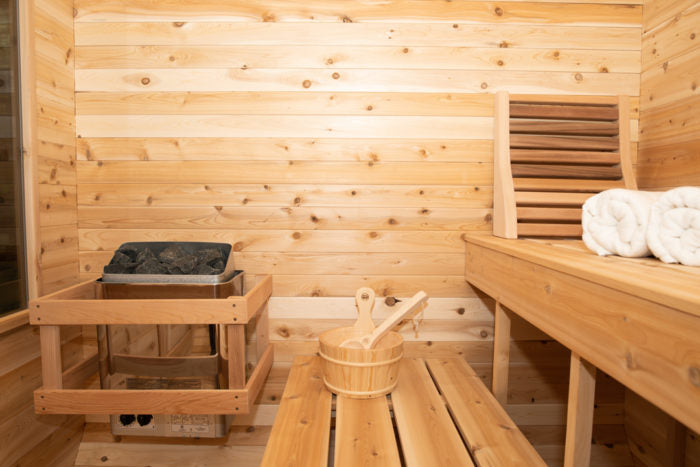Some Known Incorrect Statements About Traditional Sauna
Traditional Sauna Things To Know Before You Get This
Table of ContentsNot known Factual Statements About Traditional Sauna Some Of Traditional SaunaThe Greatest Guide To Traditional SaunaSome Of Traditional Sauna4 Simple Techniques For Traditional Sauna
Many of the weight shed in a sauna is water loss and is re-gained upon rehydrating. Without an uncertainty sauna can be a crucial component of a healthy and balanced weight loss program. To look at the differences between typical and IR saunas, I will separate these into verifiable, theoretical, and made distinctions.Hence, the hottest factor in the saunawhich goes to the ceiling directly over the sauna heateris generally between 185 and 190 F. Claims that a conventional sauna goes beyond 200 F is just not true and not suitable for electrical saunas marketed in the United States. The temperature level for a far-infrared sauna is generally established between 120 and 140 F; however, unlike the standard sauna, the goal in and IR room is not to achieve a high temperature level.
Because of this, the temperature level distinction is practically unimportant, considering that excessive sweating leads to both sauna types, but the approach of heating up the body is various. In an IR sauna the bather will certainly really feel hot and will certainly sweat a lot, however at a lot lower temperature levels. Traditional Sauna. Therefore, if the objective is to invest longer time periods in the sauna, the IR sauna is a great choice

The 45-Second Trick For Traditional Sauna

When the high temperature level is achieved, the elements cycle on and off to preserve the heat. Traditional Sauna. Most traditional sauna individuals appreciate pouring water over the rocks to create steam to increase sauna moisture levels. The benefits of putting water over the rocks consist of: making the area a lot more comfy, dampening the nasal flows, and permitting the use of aromatherapy by mixing necessary oils with the water
In a far-infrared sauna, the warmth waves pass through the body to properly heat the body and raise the body core temperature. To achieve this increased temperature, Far-infrared emitters produce infrared power which More Info is close to the very same wavelength as that which the body normally emitsoften described as the "Crucial Variety" of 7 to 14 microns), so the power is well obtained by the body.
When the energy enters the body, it creates the body temperature to boost and eventually leads to sweating. In an infrared sauna it is very important for the emitters/heaters to stay on nearly regularly. Considering that there is no mass of rocks to maintain warm, the sauna will cool if the emitters shut off.
What Does Traditional Sauna Mean?
As pointed out above, the sauna bather in an infrared area wants to place himself before operating emitters to obtain maximum gain from the warm. The heating time for the 2 spaces can be very various, depending on just how the spaces are made use of. For a traditional sauna, a bather needs to home permit 30-40 mins for the area to accomplish a desired temperature and to properly pre-heat the rocks.
A well created sauna will typically accomplish a temperature level of 150-160 F in about 30-40 minutes. For hotter temperature levels, the room may require to warmth for a longer period.

Standard saunas often tend to be bigger (for this reason use even more power) than infrared saunas, although conventional saunas are certainly available in one and 2 individual sizes. For a two-person standard sauna, 5x6 or 5x7 dimension is most prominent. The top bench can conveniently seat two or 3 individuals and is likewise long enough to lie down throughout the sauna session.
How Traditional Sauna can Save You Time, Stress, and Money.
The ordinary cost per kWH of electrical energy in the U.S. is approximately $0.11 - Traditional Sauna, so a 4.5 kW heating unit will cost about $.50 to compete one hour, if the heater runs constantly for one hour. Normally a sauna heating system will certainly compete 75% of the first hour and 50% of succeeding hours on considering that the aspects cycle once the set temperature level is accomplished
A 2 individual far-infrared area is generally literally smaller than a standard sauna, commonly about 4' x 4' or smaller. The IR furnace is usually 1.5-1.7 kW using a 120 volt 15 amp plug-in service. Considering that the area can be made use of sooner than a sauna space, we will certainly think the space is used for to of an hour including warm up time.
Ultimately, there is a seldom reviewed distinction in her response the social experience between the two rooms. While our culture has actually shed a few of the social benefit of the typical sauna experience, it can be extremely socially gratifying. From household time in the sauna, to heart-felt discussions with better halves, to sauna partiesthe conventional sauna experience can lead to intimate mingling.
Examine This Report on Traditional Sauna
Most greater end infrared spaces include tinted light therapy, audio systems and full-glass fronts.